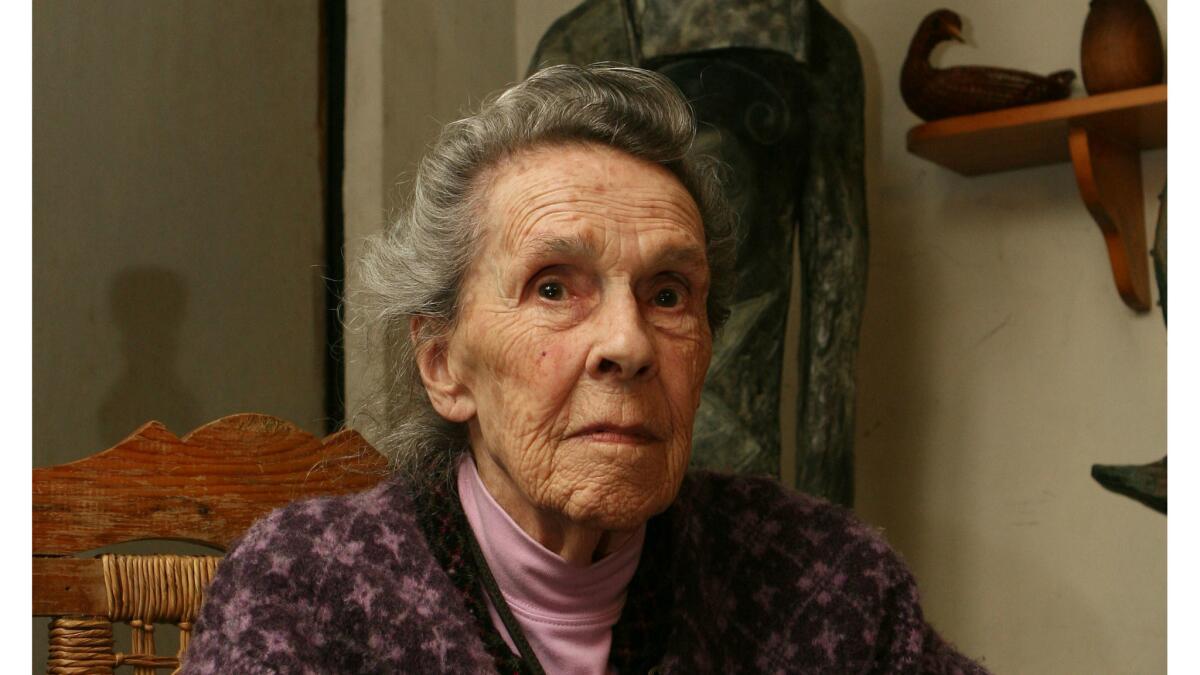Leonora Carrington, the surrealist storytelling genius you’ve never heard of

- Share via
Painter and storyteller Leonora Carrington was the kind of wild, visionary character who ought to be emblazoned on our cultural memory. Instead, she’s almost invariably relegated to footnote status, as a muse to Max Ernst and the Surrealists, a marginal figure in the grand narratives of other geniuses.
Perhaps this suited Carrington: she had little hunger for notoriety, no taste for epic statements a la Dos Passos or Hemingway. She spent her last six decades quietly making art and raising two sons. Her short, shape-shifting stories were published in small editions that flickered in and out of print over the years, cult classics feeding generations of fabulists like Angela Carter, Aimee Bender and Kathryn Davis.
Carrington grew up in a grand manor house, the daughter of a self-made British textile tycoon and his Irish wife. Her family was new money, painfully aware of their tenuous place in the “Downton Abbey”-era class structure. Proper behavior was expected of Leonora, whose nickname was Prim. She was sent to convent and finishing schools, only to escape or be expelled. In 1935, the 17-year-old debutante was presented to the court of King George. A photo taken that night shows a tall, handsome girl with porcelain skin, her satin gown slithering into a puddle around her invisible feet, as if she were a marble statue forever immobilized. Her eyes stare at the camera blankly.
The gothic fairy tales written in the following years, collected in “The Complete Stories of Leonora Carrington,” offer a hint of the dark turbulence behind those eyes. The teenage narrator of “The Debutante” finds aristocratic Britain repellent. After convincing a hyena friend to take her place at a ball, she teaches the animal how to walk in heels and covers its hairy paws in elegant gloves. What to do about the creature’s snout? They agree to rip off the maid’s face so that the hyena can use it as a mask, “nibbled very neatly all around.”
In both her prose and her visual art, Carrington dissolves the borders between human and inhuman, fantasy and reality, death and life. In “The Complete Stories” we meet a mad queen who uses squirming live sponges to wash herself; a corpse that casts a circle of light in the forest; and a horse-woman who lives among plants and animals because humans won’t accept her hybrid state. Whenever Carrington’s heroines are forced to pledge allegiance, they always choose the company of beasts.
Many of Carrington’s fictions revolve around young furies. In “The Oval Lady,” teenage Lucretia explains that she is engaged in a war of wills with her father: “I’d like to starve myself to death just to annoy him. What a pig.” She and her toy rocking horse seem to have transformative powers and they are on the verge of racing away from home when Lucretia’s nanny physically reins her in, forcing a bit between her teeth. While the girl bucks and smashes furniture, “the old woman clung to her back like a limpet to a rock.”
She writes like a painter, imagery skittering off every page, and many of her prose obsessions recur in her visual art. In the 1937 self-portrait “The Inn of the Dawn Horse” (a cropped version adorns the cover of “Complete Stories”), Carrington depicts herself as a wild-maned figure accompanied by a hyena; the rocking horse hangs on the wall behind her.
Written over 40 years, the stories in this collection often conclude with an abrupt crack, as if the author had awoken from a dream and sat bolt upright in her velvet armchair. The protagonist of “Monsieur Cyril de Guindre” resembles Huysmans’ decadent hero Des Esseintes: He dabs opium essence behind his ears and eats chickens “suffocated in vapors of boiling patchouli.” Cyril banished his wife to a sanitarium and left their baby with nuns because he craved freedom. So when his now-grown daughter appears in his garden, her presence seems both magical and threatening. Will she embrace him or poison him?
Carrington escaped her own aristocratic prison at age 20: she ran away to France with Surrealist Max Ernst, 26 years her senior. Women were often boxed into the role of the muse in Surrealist circles, worshipped as an erotic embodiment of the irrational. Carrington, so fluent in dream logic, was a perfect foil for Ernst, but she was determined to channel her unconscious into her own art. World War II interrupted their creative and amorous idyll, though: Ernst was interned in a prison camp and Carrington subsequently suffered a nervous breakdown.
She documented her dissolution in the newly reissued memoir “Down Below,” first published in a surrealist journal in 1944. It hurls us into the chaotic inner world of someone who’s lost her foothold on an increasingly grotesque reality. Carrington flees France with friends but writes of how her body began to “jam,” seized by a kind of psychological vertigo. As she attempts to cross the mountainous border from Andorra into Spain, “my will no longer meshed with my faculties of movement.” She overcomes this by hallucinating that she can communicate with animals and, like one of her own characters, momentarily joins a herd of horses.
The boundaries between Carrington’s self and the world seem to deteriorate once she gets to Spain. She believes a Dutch man she meets has “turned the people into zombies and scattered anguish like pieces of poisoned candy in order to make slaves of all.” While engulfed in this mental fog, she is gang raped and then dumped in a Madrid park. Back in the safety of her hotel, she writes with chilling simplicity, “I spent the rest of the night taking cold baths and putting on nightgowns, one after the other. One was of pale green silk, another pink.” Carrington eventually lands in a sanitarium, where doctors treat her with a precursor to electroconvulsive therapy. Andre Breton famously wrote that “beauty will be convulsive or not at all” — but there is nothing romantic in Carrington’s lived experience of enforced convulsions and deranged senses.
Although she left behind no further memoirs, “The Surreal Life of Leonora Carrington,” recently published in the UK by her journalist cousin Joanna Moorhead, vividly sketches her long life. It takes us through the artist’s postwar reunion with Ernst, who came to seem less like a liberator and more like a drag on her energies. Carrington settled in Mexico City with Magnum photographer Chiki Weisz, had two children, immersed herself in mysticism and created a hub of female creativity with artists Remedios Varos and Kati Horna.
In 1976, Carrington wrote the wonderfully funny occult novella “The Hearing Trumpet.” Imagine a feminist, fantastical alternative to “The Da Vinci Code”: 92-year-old heroine Marian Leatherby is dumped into a retirement home where she finds a gang of old ladies seeking the Holy Grail. Marian dreams of a future when “the planet is peopled with cats, werewolves, bees, and goats. We all fervently hope that this will be an improvement on humanity.” Carrington, who died in 2011, remained a wild thing until the end.
Joy Press is the author of a forthcoming book about women TV showrunners.
“The Complete Stories of Leonora Carrington”
Leonora Carrington
Dorothy, a publishing project: 232 pp, $16 paper
Leonora Carrington
NYRB Classics: 112 pp., $14 paper
More to Read
Sign up for our Book Club newsletter
Get the latest news, events and more from the Los Angeles Times Book Club, and help us get L.A. reading and talking.
You may occasionally receive promotional content from the Los Angeles Times.









